



Issues : Errors in EE
|
b. 7-9
|
composition: Op. 28 No. 3, Prelude in G major
..
Nothing indicates that the fingering of EE could be authentic. What is more, a mistake was most probably committed in b. 8 – in the middle of the bar, the b-a notes should be, apparently, played with the fingers 2-1, as they were in the previous bar, in an analogous place. In the copied fingering, it is, however, impossible to reach d at the beginning of the 4th group without crossing the fingers, which should have been marked. category imprint: Differences between sources issues: EE revisions , Errors in EE |
||||||||
|
b. 7
|
composition: Op. 28 No. 3, Prelude in G major
..
Arpeggio in EE resulted from a mistake of the engraver of EE1, who placed it in b. 7 instead of b. 8. category imprint: Differences between sources issues: Errors in EE |
||||||||
|
b. 7
|
composition: Op. 28 No. 23, Prelude in F major
..
The missing category imprint: Differences between sources issues: Errors in EE |
||||||||
|
b. 7-8
|
composition: Op. 63 No. 2, Mazurka in F minor
..
The absence of fingering in EEW must be an oversight. In the main text we give both the fingering printed in FE (→GE) and the preceding pencil addition in FES – the 4th finger on a category imprint: Differences between sources; Editorial revisions issues: Errors in EE , Annotations in FES |
||||||||
|
b. 7
|
composition: (Op. 4), Sonata in C minor, Mvt II
..
The omission of both category imprint: Differences between sources issues: EE revisions , Errors in EE |




 1, which almost certainly comes from Chopin.
1, which almost certainly comes from Chopin. in
in  in
in